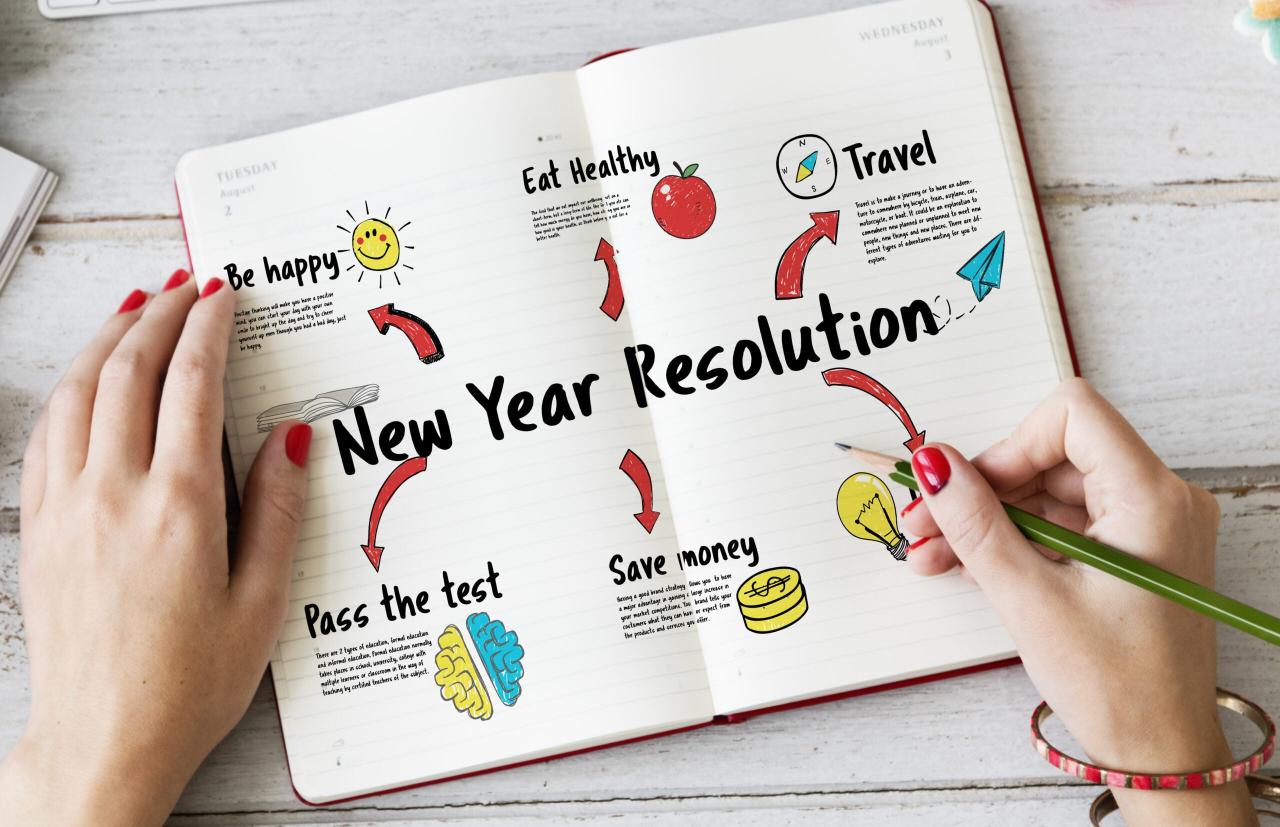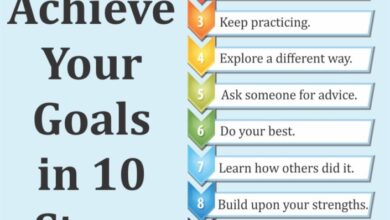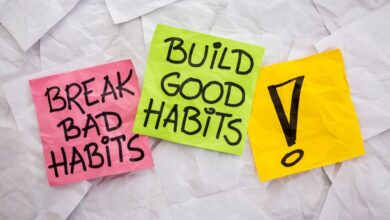
The Secret to Making Resolutions That Stick
The secret to making resolutions that stick isn’t about willpower alone; it’s about a strategic approach that combines goal setting, habit building, and a supportive mindset. Think of it as a journey, not a sprint, where you’re equipped with the tools and strategies to navigate the path towards success.
This article will delve into the seven key principles that form the foundation of achieving lasting change. We’ll explore how to set SMART goals, break down large resolutions into manageable steps, cultivate positive habits, and overcome common obstacles. We’ll also discuss the importance of mindset, seeking support, and tracking your progress.
By implementing these principles, you’ll gain the confidence and clarity needed to turn your resolutions into lasting achievements.
Building Habits
Resolutions often fail because they rely on willpower alone. Willpower is a finite resource, and it’s easy to deplete it. Habit formation, on the other hand, allows you to achieve your goals without relying on conscious effort. Habits are automatic behaviors that become ingrained in your daily routine.
By building positive habits, you can make lasting changes to your life and achieve your resolutions.
Starting Small
Starting small is crucial for building new habits. Trying to change too much at once can be overwhelming and lead to burnout. Instead, focus on making small, incremental changes. For example, if your resolution is to exercise more, start with just 10 minutes of exercise per day.
Once that becomes a habit, you can gradually increase the duration or intensity.
Consistency
Consistency is key to habit formation. It’s better to engage in a new habit for a short period every day than to do it sporadically for longer periods. This is because consistency helps to strengthen the neural pathways associated with the habit, making it more automatic.
The secret to making resolutions stick? Start small and build momentum. Instead of aiming for a drastic overhaul, try a simple challenge like the 14 day plank plan. It’s a manageable commitment that can lead to noticeable results, inspiring you to keep going and tackle bigger goals down the line.
Rewards and Accountability
Rewards can be a powerful motivator for building new habits. When you successfully complete a new habit, reward yourself with something you enjoy. This positive reinforcement will help you stay motivated. Accountability can also be helpful. Tell a friend or family member about your new habit and ask them to check in with you regularly.
This can help you stay on track and avoid falling back into old patterns.
The secret to making resolutions stick? It’s all about breaking them down into manageable steps. Sometimes, those steps can involve addressing underlying emotional triggers, like stress. If you find yourself reaching for food when you’re feeling overwhelmed, check out 7 ways to stop stress eating for some helpful tips.
Once you’ve got a handle on those emotional triggers, you’ll be well on your way to achieving your goals.
Habit Stacking
Habit stacking is a technique that involves linking a new habit to an existing one. For example, if you want to start meditating in the morning, you could stack it onto your existing habit of brushing your teeth. After you brush your teeth, you would immediately meditate for a few minutes.
This helps to make the new habit more automatic and less likely to be forgotten.
Overcoming Obstacles

Even with the best intentions and carefully crafted plans, life has a way of throwing curveballs. Obstacles can emerge, threatening to derail our resolutions and leave us feeling discouraged. These challenges can range from unexpected setbacks to internal struggles with motivation and procrastination.
The secret to making resolutions that stick? It’s all about finding ways to make them fun and sustainable. This spring, I’m making a resolution to eat more seasonal produce, and I’m starting with asparagus. Check out these 12 farmers market friendly asparagus recipes for some delicious inspiration.
With these tasty recipes, I’m confident that my resolution to eat more veggies will be a breeze.
Recognizing and addressing these obstacles is crucial for turning our resolutions into lasting changes.
Strategies for Overcoming Obstacles
Identifying common obstacles is the first step in overcoming them. Here are some common obstacles and strategies to navigate them:
- Lack of Motivation:When the initial enthusiasm fades, it’s easy to lose motivation. Strategies to combat this include:
- Reframing your perspective:Focus on the benefits of achieving your resolution rather than the effort required.
- Setting small, achievable goals:Break down your resolution into smaller, manageable steps to build momentum and avoid feeling overwhelmed.
- Finding an accountability partner:Having someone to check in with can provide support and encouragement.
- Procrastination:Procrastination is a common enemy of resolutions. Strategies to overcome it include:
- Identifying triggers:Understanding what prompts your procrastination can help you avoid those situations or develop coping mechanisms.
- Using time management techniques:Employ techniques like the Pomodoro method or time blocking to structure your day and create dedicated time for working on your resolution.
- Rewarding yourself:Celebrating small wins can help you stay motivated and on track.
- Unexpected Challenges:Life throws curveballs, and unexpected challenges can disrupt our plans. Strategies to handle them include:
- Flexibility and adaptability:Be prepared to adjust your plan as needed. Don’t be afraid to make changes if circumstances require it.
- Seeking support:Lean on friends, family, or a support group for encouragement and advice.
- Practicing self-compassion:Be kind to yourself when setbacks occur. Everyone makes mistakes, and it’s important to learn from them and move forward.
Real-Life Examples
- Sarah, a busy professional, wanted to prioritize her health and fitness.She struggled with finding time to exercise amidst a demanding work schedule. To overcome this obstacle, she started by incorporating short, 15-minute workouts into her daily routine. She also sought support from a friend who was also interested in getting fit, which helped her stay motivated and accountable.
By making small, consistent changes, Sarah achieved her goal of becoming more active.
- John, a student, wanted to improve his time management skills.He often procrastinated on assignments, leading to stress and poor grades. To address this, he started using a planner to schedule his tasks and set realistic deadlines. He also broke down large projects into smaller, more manageable steps.
By implementing these strategies, John was able to improve his time management skills and achieve better academic results.
The Role of Mindset: The Secret To Making Resolutions That Stick

Your mindset plays a crucial role in the success of your resolutions. It’s not just about setting goals; it’s about the beliefs and attitudes you hold towards yourself and your ability to achieve them.
The Impact of Mindset on Resolution Success, The secret to making resolutions that stick
A positive mindset is essential for achieving your resolutions. When you believe in yourself and your ability to succeed, you’re more likely to take action, persevere through challenges, and ultimately reach your goals. Conversely, a negative mindset can sabotage your efforts, leading to self-doubt, procrastination, and giving up.
Positive Self-Talk, Self-Belief, and Resilience
Positive self-talk, self-belief, and resilience are key components of a successful mindset.
Positive Self-Talk
Positive self-talk is the act of replacing negative thoughts with positive ones. It’s about consciously choosing to focus on your strengths and abilities, rather than dwelling on your weaknesses or limitations. For example, instead of saying, “I’ll never be able to stick to this diet,” you might say, “I’m committed to making healthy choices and I’m already seeing positive results.”
Self-Belief
Self-belief is the conviction that you can achieve your goals. It’s about trusting in your abilities and believing in your potential. You can cultivate self-belief by setting realistic goals, celebrating your successes, and learning from your setbacks.
Resilience
Resilience is the ability to bounce back from setbacks and challenges. It’s about maintaining a positive attitude and a belief in your ability to succeed, even when things get tough. Developing resilience involves learning from your mistakes, seeking support from others, and practicing self-compassion.
Examples of Positive Affirmations
Positive affirmations are powerful statements that can help you cultivate a positive mindset. Here are some examples of affirmations that can support resolution achievement:
- I am committed to achieving my goals.
- I am strong, capable, and resilient.
- I believe in myself and my ability to succeed.
- I am grateful for the progress I’m making.
- I am worthy of success.
Closing Notes

Remember, the journey of achieving resolutions is not a straight line; it’s a path filled with twists and turns. Embrace the process, celebrate your wins, and don’t be afraid to adjust your course when needed. By adopting a strategic approach, seeking support, and staying true to your goals, you can unlock the power of lasting change and transform your resolutions into tangible realities.






